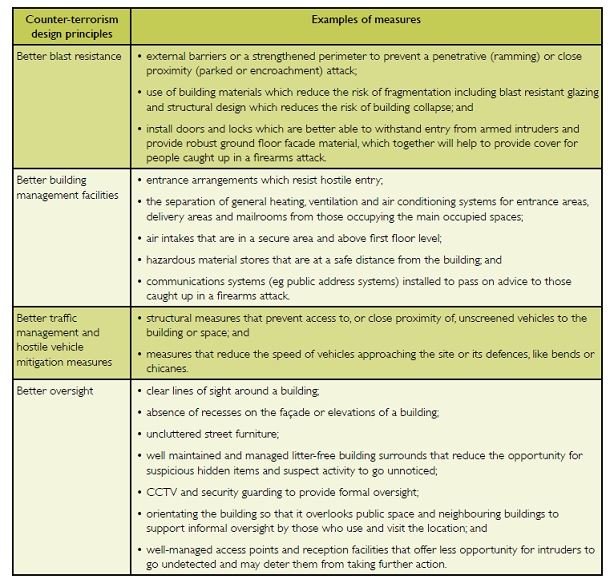Urban terrorism
Urban terrorism is the threat of terrorists applied to the urban environment. When this threat is directed at people, it is covered under the security issue of Mass killing. When directed at objects, it is covered under the security issue of Destruction by fanatics
Contents
Description
Urban terrorism is a major concern in urban security, although, compared to common violence and crime or everyday car accident risk, number of incidents and death tolls are rather small. However, it "[…] is one type of violence that has serious consequences for cities in both developed and developing countries".[1]
Objectives of urban terrorism
Contrary to everyday violence, urban terrorism seeks to sustainably unsettle and disrupt urban infrastructure and urban life, at most times involving fatalities or severe injuries of civilians. Urban agglomerations, density of built environment and urban mass transport infrastructure result in mass gathering and, thus, make easy targets to maximize the impact of terrorist attacks with respect to both social and structural harm (as experienced in the Mumbai suburb bombings, the Madrid train bombing, 9/11 and many more).
Strategies for defending against urban terrorism
A couple of general strategies of urban defence include the following (Coaffee 2003):[2]
- The management of landscape (enforcement of spatial and temporal regulations and rules);
- The fortification approach with defensive measures (such as walls, barriers or gates) for physical segregation of the landscape;
- The surveillance approach (space control via cameras and security staff);
- The managerial approach (enhancement of legal and police control).
Countering urban terrorism by urban planning
Hidek (2007) correctly notes, that "anti-terrorism planning is impacting urban planning" and shaping the cities, and that citizen-oriented security for cities is required. He refers to counter-terrorism planning ("designing out" terrorism) such as the following:[3]
- The narrowing of city entering roads;
- Traffic decelerating street planning (such as tight sequences of S-shaped curves);
- The installation of thousands of security cameras;
- The installation of concrete medians between lanes or at entry points into business districts or subway stations;
- The construction of bollards, barriers and fences building protection.
In its guide on design and technical issues for protecting crowded places the UK Home Office in partnership with the Department for Communities and Local Government gives "advice about counter-terrorism protective security design" for planning, designing and developing built environment. As key mitigation strategies access control and air intake protection are recommended for CBR material and firearms attacks and following suggestions referring to design and structural adaptations are given:[4]
- Installing communications;
- Installing doors and locks and robust floor facades;
- Incorporation of firearms attack scenario into emergency plans.
Counter terrorism protective security measures help to identify, to prevent and postpone terrorist attacks, based on the principle of "deter, detect, delay".[5] The challenge remains to combine protective security measures with the application of general urban design principles, respectively applying protective security measures without interfering with the key principles of well-designed places, which are:
- Character;
- Continuity and enclosure;
- Quality of public realm;
- Ease of movement;
- Legibility;
- Adaptability;
- Diversity.
Counter-terrorism urban design principles
“Designing-in” approaches, on one hand, (throughout the process from concept stage to planning approval) and collaborative working with all community parts will result in more cost effective, aesthetic and functional benefits. On the other hand, “Designing out crime (including terrorism) at the earliest stages in the planning process can be extremely effective in developing safer and more secure environments in which people can live and work”.[6] To check planning applications on counter-terrorism protective security dimensions and provide advice architectural liaison officers and units are strongly recommended.
The following four key counter-terrorism design principles have been promulgated by authorities:[7]
Footnotes and references
- ↑ UN-HABITAT (2007): Global Report on Human Settlements 2007. Enhancing Urban Safety and Security. United Nations Human Settlement Programme: London, p. 65. Retrieved from http://www.unhabitat.org/downloads/docs/GRHS.2007.0.pdf [2012-04-13].
- ↑ Coaffee Jon (2003): Terrorism, Risk and the City: The Making of a Contemporary Urban Landscape. Ashgate Pub Ltd: Hants, p. 45.
- ↑ Hidek Matt (2007): Networked Security in the City: A Call to Action for Planners. Planners network: The Organisation of Progressive Planning. Last updated: 03/12/2012 03:02:55. Retrieved from http://www.plannersnetwork.org/publications/2007_fall/hidek.html [2012-04-13].
- ↑ HM Government (2012): Crowded Places: The Planning System and Counter-Terrorism. Home Office in partnership with the Department for Communities and Local Government. Crown Copyright. Online: http://www.homeoffice.gov.uk/publications/counter-terrorism/crowded-places/planning-and-ct?view=Binary (last access: 02.02.2012), p. 3.
- ↑ Ibid., pp. 10 and 31.
- ↑ Ibid., p. 45.
- ↑ Ibid., p. 10.
